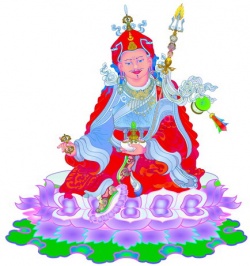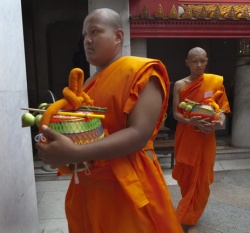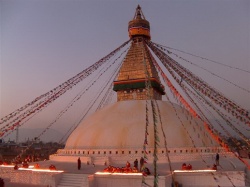Difference between revisions of "Shambhala Lineage, by Chogyam Trungpa"
m (Text replacement - "awake" to "awake") |
|||
| Line 11: | Line 11: | ||
Finally, the [[wisdom]] of [[Wikipedia:Absolute (philosophy)|ultimate]] and inner [[drala]] can be transmitted to a living [[human being]]. In other words, by [[realizing]] completely the [[cosmic mirror]] [[principle]] of unconditionality and by invoking that [[principle]] utterly in the brilliant [[perception]] of reality,a [[human being]] can become living drala—living [[magic]]. That is how one joins the [[lineage]] of [[Shambhala]] [[warriors]] and becomes a [[master]] warrior—not just by invoking but by [[embodying]] [[drala]]. | Finally, the [[wisdom]] of [[Wikipedia:Absolute (philosophy)|ultimate]] and inner [[drala]] can be transmitted to a living [[human being]]. In other words, by [[realizing]] completely the [[cosmic mirror]] [[principle]] of unconditionality and by invoking that [[principle]] utterly in the brilliant [[perception]] of reality,a [[human being]] can become living drala—living [[magic]]. That is how one joins the [[lineage]] of [[Shambhala]] [[warriors]] and becomes a [[master]] warrior—not just by invoking but by [[embodying]] [[drala]]. | ||
| − | The [[master warrior]] [[embodies]] the outer [[drala]] [[principle]]. The basic quality of the [[master warrior]] is that his presence evokes the [[experience]] of the [[cosmic mirror]] and the [[magic]] of [[perception]] in others. That is, his very being {{Wiki|transcends}} [[duality]] on the spot, and thus he is said to have complete [[Wikipedia:Authenticity|authentic]] presence. When the [[warrior]] students [[experience]] this overwhelming genuineness, it allows them and provokes them to go beyond their own [[selfishness]], beyond [[ego]], in an instant. The [[master warrior]] has [[relaxed]] completely into the unconditional [[purity]] of the [[cosmic mirror]]. Therefore, he has [[experienced]] unconditional wakefulness, free from [[ego]]. Because he always has access to that [[unconditioned]] [[space]], he is never [[subject]] to the [[confusion]] or sleepiness of [[selfishness]], at all. He is totally | + | The [[master warrior]] [[embodies]] the outer [[drala]] [[principle]]. The basic quality of the [[master warrior]] is that his presence evokes the [[experience]] of the [[cosmic mirror]] and the [[magic]] of [[perception]] in others. That is, his very being {{Wiki|transcends}} [[duality]] on the spot, and thus he is said to have complete [[Wikipedia:Authenticity|authentic]] presence. When the [[warrior]] students [[experience]] this overwhelming genuineness, it allows them and provokes them to go beyond their own [[selfishness]], beyond [[ego]], in an instant. The [[master warrior]] has [[relaxed]] completely into the unconditional [[purity]] of the [[cosmic mirror]]. Therefore, he has [[experienced]] unconditional wakefulness, free from [[ego]]. Because he always has access to that [[unconditioned]] [[space]], he is never [[subject]] to the [[confusion]] or sleepiness of [[selfishness]], at all. He is totally awake. And thus, also, the [[energy]] of the [[master warrior]] is always connected with [[Wikipedia:Absolute (philosophy)|ultimate]] [[drala]], the vast [[vision]] of the [[Rigden kings]]. So he is free from [[confusion]]. |
Because the [[master warrior]] has completely identified himself with the [[lineage]] of [[wisdom]] of the [[Rigden kings]], he begins to develop great tenderness, [[great compassion]], which is witnessing [[basic goodness]] in all [[beings]]. When the [[master warrior]] [[views]] the [[world]] around him, he [[knows]] that all [[human beings]] possess [[basic goodness]] and that they are entitled to realize the [[principle]] of their own genuineness, at least. And beyond that, they have the possibility to give [[birth]] to the [[universal monarch]] in themselves. | Because the [[master warrior]] has completely identified himself with the [[lineage]] of [[wisdom]] of the [[Rigden kings]], he begins to develop great tenderness, [[great compassion]], which is witnessing [[basic goodness]] in all [[beings]]. When the [[master warrior]] [[views]] the [[world]] around him, he [[knows]] that all [[human beings]] possess [[basic goodness]] and that they are entitled to realize the [[principle]] of their own genuineness, at least. And beyond that, they have the possibility to give [[birth]] to the [[universal monarch]] in themselves. | ||
Latest revision as of 14:01, 30 December 2014
Making the journey of warriorship depends first of all on your personal realization of genuineness and basic goodness. Ultimately, giving up selfishness, or ego, is only possible if you have a living, human example—someone who has already done so, and therefore makes it possible for you to do the same. The notion of lineage in the Shambhala teachings is how the complete realization of sanity can be handed down to a human being in the Shambhala world so that he or she can embody that sanity and promote its attainment in others.
Fundamentally, the notion of lineage in the Shambhala teachings is connected with how the wisdom of the cosmic mirror is transmitted and continued in human life, human existence. The quality of the cosmic mirror is that it is unconditioned, vast open space. It is an eternal and completely open space, space beyond question. In the realm of the cosmic mirror, your mind extends its vision completely, beyond doubt. Before thoughts, before the thinking process takes place, there is the accommodation of the cosmic mirror, which has no boundary—no center and no fringe. As we discussed, the way to experience this space is through the sitting practice of meditation.
Experiencing the realm of the cosmic mirror gives rise to wisdom—the wisdom of vast and deep perception, beyond conflict, which is called drala. There are various levels of experiencing drala. The primordial or ultimate level of drala is experiencing directly the wisdom of the cosmic mirror. When you experience that wisdom, then you are contacting the origin of the Shambhala lineage, the source of wisdom.
So, when you contact the wisdom of the cosmic mirror, you are meeting the ultimate dralas, the Rigden kings of Shambhala. Once having made a connection to ultimate drala, it is possible for the primordial wisdom and vision of the Rigden kings to be passed down to the level of human perception. The vastness of perception can be captured in simplicity, a single perception, on the spot. When we allow vastness to enter our perception, then it becomes drala; it becomes brilliant and luminous—magical. When we have this experience, then we are meeting what are called the inner dralas. The inner dralas are empowered by the wisdom of the cosmic mirror, the Rigdens, to manifest brilliance and elegance in this phenomenal world.
Finally, the wisdom of ultimate and inner drala can be transmitted to a living human being. In other words, by realizing completely the cosmic mirror principle of unconditionality and by invoking that principle utterly in the brilliant perception of reality,a human being can become living drala—living magic. That is how one joins the lineage of Shambhala warriors and becomes a master warrior—not just by invoking but by embodying drala.
The master warrior embodies the outer drala principle. The basic quality of the master warrior is that his presence evokes the experience of the cosmic mirror and the magic of perception in others. That is, his very being transcends duality on the spot, and thus he is said to have complete authentic presence. When the warrior students experience this overwhelming genuineness, it allows them and provokes them to go beyond their own selfishness, beyond ego, in an instant. The master warrior has relaxed completely into the unconditional purity of the cosmic mirror. Therefore, he has experienced unconditional wakefulness, free from ego. Because he always has access to that unconditioned space, he is never subject to the confusion or sleepiness of selfishness, at all. He is totally awake. And thus, also, the energy of the master warrior is always connected with ultimate drala, the vast vision of the Rigden kings. So he is free from confusion.
Because the master warrior has completely identified himself with the lineage of wisdom of the Rigden kings, he begins to develop great tenderness, great compassion, which is witnessing basic goodness in all beings. When the master warrior views the world around him, he knows that all human beings possess basic goodness and that they are entitled to realize the principle of their own genuineness, at least. And beyond that, they have the possibility to give birth to the universal monarch in themselves.
Therefore, great generosity and great compassion take place in the mind of the master warrior. He finds that the Great Eastern Sun has entered his heart completely, so completely that he actually manifests the brilliance of the Great Eastern Sun, extending its light rays to sentient beings who suffer in the twilight of the setting sun. The master warrior sees the complete path of warriorship, and he is able to extend that path, provide that path, to warrior students—to any human being who longs to fulfill his or her precious human birth.
Finally, the master warrior, out of his great compassion for human beings, is able to join heaven and earth. That is to say, the ideals of human beings and the ground where human beings stand can be joined together by the power of the master warrior. Then heaven and earth begin to dance with each other, and human beings feel that there is no quarrel about who possesses the best part of heaven or the worst part of earth.
In order to join heaven and earth, you need confidence and trust in yourself. Beyond that, in joining heaven and earth, you have to go beyond selfishness. If someone thinks: “Now I have it? Ha, ha!”—that doesn’t work. Joining heaven and earth happens only if you go beyond an egoistic attitude. No one can join heaven and earth together if he is selfish, because then he has neither heaven nor earth. He is stuck instead in a plastic realm, an artificial realm, which is horrific. Joining heaven and earth comes only from passionlessness, transcending desire. If the master warrior were drunk on his own authentic presence, then it would be disastrous.
The master warrior is very humble, extremely humble. His humbleness comes from working with others. When you work with others, you realize the need to be patient, to give space and time to others to develop their own understanding of goodness and of warriorship. If you are frantic and try to push basic goodness onto others, then nothing happens except further chaos. Knowing that, you become extremely humble and patient in working with others.
The master warrior guides his students with patience, and he also provides gentleness—being without
aggression. Then, he also guides his students by being true—being stable and solid. If truth were like a
fluttering flag in the wind, you would never know which side you were looking at. So the idea here is that being true is being solid and completely stable, like a mountain. You can rely on the sanity of the master warrior; it never wavers. He is completely genuine.
Because there is no fear in the master warrior’s own state of mind or in his physical being, the process of helping others takes place constantly. The mind of the master warrior is thoroughly free from laziness. In extending himself fearlessly to others, the master warrior expresses intense interest in the activities of his students — from the level of what they have for dinner up to the level of their state of mind, whether they are happy or sad, joyful or depressed. So mutual humor and appreciation can take place naturally between the master warrior and the warrior students.
But most important, in every activity of his life, in every action he takes, there is always magic—always. In whatever he does, the master warrior of Shambhala guides the minds of his students into the visionary mind of the Rigden kings, the space of the cosmic mirror. He constantly challenges his students to step beyond themselves. The challenge that he provides is not so much that he is always setting hurdles for his students or egging them on. Rather, his authentic presence is a constant challenge to be genuine and true.
Altogether then, the idea of lineage in the Shambhala teachings relates to one’s connection with primordial wisdom. That wisdom is accessible and extremely simple, but also vast and profound. The way to despotism and corruption lies in clinging to concepts, without access to a pure realm in which hope and fear are unknown. In the realm of the cosmic mirror, clinging to concept and doubt has never been heard of, and those who have proclaimed the true goodness, the innate primordial goodness, of human beings, have always had access to this realm, in some form.
Over the centuries, there have been many who have sought the ultimate good and have tried to share it with their fellow human beings. To realize it requires immaculate discipline and unflinching conviction. Those who have been fearless in their search and fearless in their proclamation belong to the lineage of master warriors, whatever their religion, philosophy, or creed. We should venerate their example and acknowledge the path that they have laid for us. They are the fathers and mothers of Shambhala, who make it possible, in the midst of this degraded age, to contemplate enlightened society.
Rediscovering our Wisdom and Compassion
The ancient kingdom of Shambhala was renowned for the compassion and wisdom of its leaders and citizens. According to the legend of Shambhala, these qualities were the result of unique teachings on enlightened society that the Buddha gave personally to King Dawa Sangpo, the first sovereign of Shambhala.
These instructions have been preserved over the centuries and are held by a hereditary lineage of teachers that hold the title “Sakyong.” It is a royal title that means “Earth Protector.”
The first Sakyong in modern times was the Tibetan meditation master, Chögyam Trungpa Rinpoche (the Tibetan title, Rinpoche, means “precious one” and denotes a rare and profound teacher). Prior to his escape from Tibet in 1959, he was the holder of numerous meditative lineages and leader of a large monastic complex.
A Societal Vision
Witnessing the demise of his Tibetan culture, and how full of turmoil and pain the world was, Chögyam Trungpa went into a great period of self-reflection and meditation. He came to realize that the ancient teachings of Shambhala were more relevant and necessary then ever, given the immense challenges facing the planet. Beginning in the 1970s, he began to present a societal vision based on the Shambhala principle that proclaims the inherent goodness of all humanity.
Chögyam Trungpa felt that if humanity were to succeed in creating a better world it would be based on global respect for fundamental human dignity. This is the core message of Shambhala. His teachings were gathered together into his best-selling book, Shambhala: the Sacred Path of the Warrior, and many other writings, films and recordings.
Feeling such conviction in this, Chögyam Trungpa began training his firstborn son as the inheritor of this lineage. His son, now the lineage holder of Shambhala, is Sakyong Mipham Rinpoche. Enthroned as Sakyong in 1995, he went through extensive training in both Eastern and Western traditions, and holds a unique perspective on the universal values of the human spirit.
Sakyong Mipham is recognized in the Tibetan tradition as the incarnation of Mipham the Great, one of the most revered meditation masters of Tibet. His books include Turning the Mind into an Ally, Ruling Your World and Running with the Mind of Meditation.
The Sakyong’s teachings stress the widely held feeling that humanity is at a crossroads. He urges us to undergo a global self-reflection about our core principles, believing that how humanity feels about itself is critical for our future, and that of our planet. This vision of a society trusting and believing in its inherent worthiness is the basis of what the Shambhala Lineage calls enlightened society.
“The world is in absolute turmoil. The Shambhala teachings are founded on the premise that there is basic human wisdom that can help solve the world’s problems … Shambhala vision teaches that, in the face of the world’s problems, we can be heroic and kind at the same time.”
– Chögyam Trungpa Rinpoche
“The history and legend of Shambhala is based upon a great community that was able to reach a higher level of consciousness. This community could occur because its individual members participated fully in creating a culture of kindness, generosity and courage.”
– Sakyong Mipham Rinpoche






